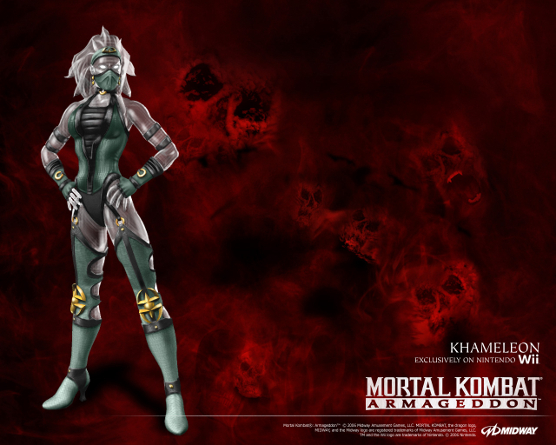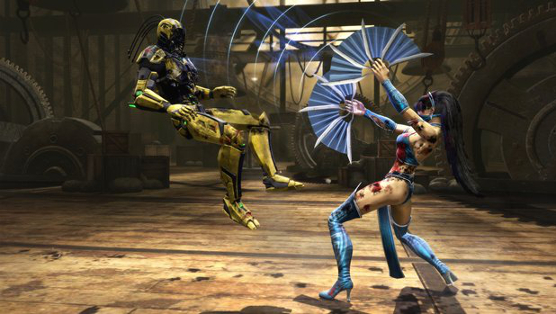Mortal Kombat X is out today, and if you’re a newcomer to MK fandom, you might need a quick rundown on the series’ peaks and valleys. Let us don our jewel-toned leotards and face masks as we take a trip together down the skull-bedecked memory lane of this goofy gorefest.
1. Necessitating the ESRB Rating System
We have Mortal Kombat to thank for the invention of not only the “M” rating but the entire ESRB system. The first two Mortal Kombat games weren’t solely known as America’s response to the international success of Street Fighter; they were also at the forefront of a widespread moral panic about violent videogames. The Mortal Kombat series explored the uncharted territory of games made with adults in mind—or, at least, games made with teenagers in mind. The pixelated gore of these early games may look pretty tame to our modern-day desensitized eyes, but at the time, Mortal Kombat resulted in a lot of awkward conversations as parents everywhere figured out that videogames weren’t going to be family-friendly by default anymore.
2. Friendship Fails
In response to the outcry about the violence in the first Mortal Kombat game, the sequel included a “Friendship” Fatality, which meant players could end a battle with a funny animation and a truce instead of a gory finishing move. This type of fourth wall winking was a hallmark of the early Mortal Kombat games, which also included “Babality” finishing moves that turned an opponent into an infant. The latter-day Mortal Kombat games attempted to take themselves a bit more seriously, with some success.
3. The Motion Control Fad
The introduction of the third dimension in Mortal Kombat 4 might make for a better cultural touchstone, but the decision to add Mortal Kombat: Armageddon to the Nintendo Wii’s roster in 2007 is one that has baffled me to this day. Using the Wiimote and nunchuck to play Mortal Kombat felt weird and hilarious; there was the option to use a controller, too, but I remember spending far more time on the motion controls than necessary because the novelty of the attempt impressed me.
At the time, I scoffed at the Wii as not being “hardcore” enough to deserve a title like Mortal Kombat, but in retrospect, I was just being a jerk. Also, Khameleon was only available in the Wii version, and she ended up being one of my favorites, so maybe my past self should have stopped being so judgmental. The game also had a weird Mario Kart-inspired racing mode called Motor Kombat, and a “Kreate A Fighter” mode. Just be grateful that I didn’t include an item on this list about how often Mortal Kombat shoehorns the letter “K” into places where it doesn’t belong.
4. Scorpion’s Kunai
Scorpion’s signature weapon has always been a spear-head called a kunai, but it wasn’t always attached to a chain implanted inside of Scorpion’s arm/torso/who-knows-where-he’s-keeping-that-chain. Everybody loves to hate the Mortal Kombat film, including me, so this list item is a not-so-secret opportunity for me to link the scene in the film that makes me laugh the hardest: Johnny and Scorpion’s forest face-off. In this scene, Scorpion’s kunai emerges from his hand in a moment of delightfully bad CG weirdness. In the current games, the pointy end still comes out of Scorpion’s hand, and like it or not we have the film continuity to thank for that unsettling concept. I guess Scorpion stores all that extra chain length in the same place clowns store their infinite scarves, which is to say, an unknowable black hole of terror buried inside a humanoid form.
5. 2D? 3D? How about 2.5D!
The late 2000s saw a lot of arguments among Mortal Kombat fans about the direction that the 2011 reboot might take. One of my favorite internet debates centered around the age-old 2D versus 3D question. The first few Mortal Kombat games were in 2D; the next few were in 3D; fan disagreement about which Mortal Kombat games are “the best” could power a perpetual motion machine. 2011’s Mortal Kombat 9 settled on “2.5D,” and it also attempted to straddle the line between the goofiness of the early 2D arcade fighters and the more serious-minded 3D Mortal Kombat games. Personally, I’m not sure MK9 succeeded at incorporating the best of both worlds – but I’ll leave that argument to the comment section.
6. Whitewashing Edenia – and America
Fighting games often get a bad rap for being collections of racist caricatures. I’ve heard American players blame fighting games’ missteps on Japan’s supposedly “backwards” culture, which is ironic, because that’s racist and hypocritical. We know how to do racism, sexism, and hyper-violence right here in the US of A, and Mortal Kombat is proof of that!
Jax, the franchise’s first black character, never seems to survive through to the end of a narrative campaign. Johnny and Sonya, two all-American blondes, get framed as the “heroes” in MK9 … even though the MK fandom largely agrees that both are obnoxious brats (or is that just me?).
Speaking of American characters, Nightwolf is meant to be an Apache warrior, except his characterization is packed with stereotypes and inaccuracies about Apache culture.
Meanwhile, Mortal Kombat’s fantastical land of “Edenia” seems to have gotten a lot paler over time. Jade’s skin tone, for example, has varied from game to game, leaving fans unsure whether to claim her as an early example of a black videogame heroine or a sad example of how often black characters in games get white-washed.
This example isn’t so much a “moment” as it is a slow burn of disappointment.
7. Mortal Kombat Makeovers
We’re all the way up to the present day, and since I’ve only had Mortal Kombat X for a few hours now, I can’t say for sure what will end up being its historic takeaway (hopefully not their choice to offer “easy Fatalities” as paid DLC). If I had to pick right out of the gate, though, I’d choose the costume redesigns.
Mortal Kombat 9’s outfits, especially for the female characters, disappointed me; that game also implemented a battle damage system that would impart rips to the fighters’ clothes as they took hits in-game. Given that the female characters had very little clothing on to start out, their “battle damage” costumes would result in even tinier outfits clearly meant to titillate the player, whereas the male characters’ battle damage was barely noticeable at all.
Mortal Kombat X’s designs present a stark contrast to MK9; the ladies are finally decked out in outfits that are visually striking as well as battle-ready and practical. Even Mileena, whose performative sexiness is a big part of her style, gets to wear an outfit that strikes a balance between “succubus” and “reasonable boob support” (see above).
I never had a problem with Mortal Kombat’s blood-spurting, spine-tearing, vomit-inducing fatalities, but seeing them done by a lady in ill-supporting, tear-away lingerie irritated me to no end. I’m thrilled to play a game packed with disgusting innards and practical sports bras!




